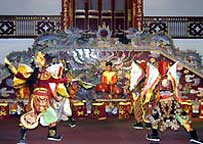The integration ceremony took place in the presence of the UNESCO director general Koichiro Matsuura and Turkish Minister of Culture and Tourism Ertugrul Gunay.The list integrates 90 different cultural elements proclaimed as Masterpieces of the Oral and Intangible Heritage of Humanity by UNESCO in 2001, 2003 and 2005. The list, according to a 2003 convention, seeks to recognize and preserve living components of cultural heritage, such as oral traditions and expression, performing arts, social practices and rituals, festivals, knowledge and practices concerning nature and the universe, and traditional craftsmanship. Nha nhac was proclaimed in 2003 and gong culture was proclaimed in 2005.
The 90 cultural expressions and spaces on the list are located in 70 countries worldwide, with 14 from Africa, eight from Arab states, 30 from the Asia-Pacific region, 21 in Europe and 17 in Latin America and the Caribbean.
According to UNESCO’s website, nha nhac, literally meaning “elegant music”, refers to a broad range of musical and dance styles performed at the Vietnamese royal court from the 15th to mid-20th century.
 Nha nhac was generally featured at opening and closing ceremonies associated with anniversaries, religious holidays, coronations, funerals and official receptions. Performances featured numerous singers, dancers and musicians dressed in sumptuous costumes. Large orchestras included a prominent drum section and many other types of percussion instruments, as well as a variety of wind and string instruments. All performers had to maintain a high level of concentration and were expected to follow each step of the ritual meticulously.
Nha nhac was generally featured at opening and closing ceremonies associated with anniversaries, religious holidays, coronations, funerals and official receptions. Performances featured numerous singers, dancers and musicians dressed in sumptuous costumes. Large orchestras included a prominent drum section and many other types of percussion instruments, as well as a variety of wind and string instruments. All performers had to maintain a high level of concentration and were expected to follow each step of the ritual meticulously.
Among numerous musical genres that have developed in Vietnam, only nha nhac can claim a nationwide scope and strong links with traditions in other East Asian countries. The genre developed during the Le dynasty (1427-1788) and became highly institutionalized and codified under the Nguyen monarchs (1802-1945) as a symbol of the dynasty’s power and longevity.
The role of nha nhac was not limited to musical accompaniment for court rituals, however. It also provided a means of communicating with and paying tribute to the gods and past kings, as well as transmitting knowledge about nature and the universe.
But events that shook Vietnam in the 20th century – especially the fall of the monarchy and decades of war are threatened the survival of nha nhac. Deprived of its court context, the musical tradition lost its original function, surviving only through the efforts of some former court musicians.
Certain forms of nha nhac have been maintained in popular rituals and religious ceremonies and serve as a source of inspiration for contemporary Vietnamese music.
The cultural space of the gongs in Tay Nguyen (the Central Highlands) of Vietnam covers several provinces and seventeen Austro-Asian and Austronesian ethno-linguistic communities.
Closely linked to daily life and the cycle of the seasons, their belief systems form a mystical world in which the gongs produce a privileged language between men, divinities and the supernatural world.
Behind every gong hides a god or goddess who is all the more powerful when the gong is older. Every family possesses at least one gong, which indicates the family’s wealth, authority and prestige and also ensures its protection.
While a range of brass instruments is used in the various ceremonies, the gong alone is present in all the rituals of community life and is the main ceremonial instrument. Each instrumentalist carries a different gong measuring between 25 and 80cm in diameter.
The manner in which the gongs are played varies according to the village. From three to 12 gongs are played by village ensembles made up of men or women. Different arrangements and rhythms are adapted to the context of the ceremony, for example, the ritual bull sacrifices, the blessing of the rice or mourning rites.
But economic and social transformations have drastically affected the traditional way of life of these communities and no longer provide the original context for the gong culture. Transmission of this way of life was also severely disrupted during the war decades. Old craftsmen are disappearing and the interest of young people has shifted towards Western culture. Stripped of their sacred significance, the gongs are sometimes sold for recycling or exchanged for other products.
At this week’s meeting, therefore, the committee also considered ways to increase public awareness, especially among youth, of the importance of safeguarding intangible heritage. Vietnam also submitted to UNESCO an application for quan ho (Bac Ninh folk love duets) to be recognized as an intangible cultural heritage of humanity.